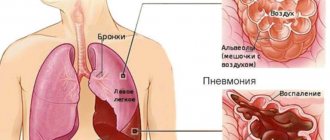Bilateral pneumonia is a serious disease with a fairly high mortality rate. Bilateral lung damage poses a particular danger to human life. The pathological process can be primary when infection occurs simultaneously in both lungs. Secondary development of bilateral pneumonia is possible when inflammation in one lung becomes chronic and spreads to the other side. Often, bilateral pneumonia is a complication of immunodeficiency conditions, heart attacks, and congestive processes in the chest.
Early medical research showed that the most common causative agents of bilateral pneumonia were coccal bacteria. Recently, confirmed evidence of damage to lung tissue by atypical infectious agents - viruses, fungi, and non-specific bacteria - has increasingly appeared.
Bilateral pneumonia is characterized as the most severe damage to alveolar tissue. According to statistics, the mortality rate from this disease is about 9%. In case of recovery, there is still a possibility of developing irreversible changes in the structure of the lungs and other diseases of the respiratory system.
How does it arise?
The occurrence of bilateral pneumonia develops when an infectious agent is introduced against the background of reduced general immunity.
There can be several ways of infection:
- Airborne - the pathogen is inhaled with air that contains microparticles of the secretions of a sick person.
- Aspiration from the oro- and nasopharynx - after settling on the mucous membrane of the upper respiratory tract, after a few days the infection “descents” into the bronchi, and then into the lungs.
- Hematogenous - a descending or ascending route of infection from the main focus.
- Lymphogenic - an infectious agent is transported into the lung tissue with a flow of lymphatic fluid during thoracic wounds.
Most often, the disease develops through airborne infection.
Under the influence of bacterial or viral flora, a violation of cellular immunity occurs, a disorder of local metabolism and innervation of the bronchial tree and lungs.
The development and further progression of the disease occurs in several stages:
- Hot flash - lasts from 12 to 72 hours, during which the vessels of the lungs are intensively filled with blood, signs of fibrinous exudation appear in the alveoli.
- Red hepatitis - lasts 24-72 hours. During this time, compactions form in the lung tissue, the texture of which is similar to the liver. The exudate that sweats from the alveoli contains a lot of red blood cells.
- Gray hepatitis - can last from 48 hours to a week. During this period, red blood cells breakdown occurs. At the same time, large numbers of leukocytes enter the alveoli.
- Resolution - characterized by gradual restoration of lung tissue. May take quite a long time.
The development of bilateral pneumonia is promoted by various diseases and conditions that cause a decrease in the body’s immune functions:
- Bad habits.
- Frequent psycho-emotional stress.
- Chronic physical overstrain.
- Long-term use of air conditioning.
- Periodic disorders of consciousness of any origin.
- Frequent epileptic seizures.
- Staying on artificial ventilation.
Predisposing factors contribute to impaired blood circulation in the pulmonary circulation, which invariably causes damage to specific cells - bronchioles and alveoli.
Bilateral pneumonia - symptoms, treatment, consequences, mortality rate
Bilateral pneumonia is a dangerous condition that occurs when there is inflammation of the lung tissue, which is caused by bacterial agents. A common cause of 2-sided pneumonia is pneumococcus (streptococcus pneumoniae). It is this microorganism that causes mortality from the disease (about 20% of cases).
In medical language, bilateral inflammatory changes in the pulmonary parenchyma are called “lobar”. This characteristic of pathology was introduced because morphological changes during lung infiltration resemble grains of oat grain.
The disease is placed in a special category due to specific morphological changes in the lung tissue. At the initial stage of damage to the alveolar acini, small hemorrhages are observed - the “red hepatization” stage. After some time, the areas of tissue damage become inflamed and covered with fibrin - the “gray hepatization” stage. The process ends with resolution or death with the development of respiratory failure.
Double pneumonia ends tragically with inadequate antibiotic therapy and reduced human immunity.
When the functionality of the protective barriers of the respiratory tract is impaired (lack of immunoglobulins and alveolar macrophages), bacterial agents easily penetrate the respiratory epithelial cells and multiply rapidly. Then they are transported through the lymphatic system, blood, and thus cause bilateral pneumonia.
The main route of transmission of infection is airborne droplets. Bacteria are transmitted from a sick person or carrier to a healthy one.
Types of pathogens
Bilateral pneumonia flares up when a certain group of microorganisms - viruses, bacteria, rods - enters the respiratory tract. The clinical symptoms and features of the therapeutic approach depend on the type of infectious agent.
Pneumococcus
The pathogen is well preserved in an anaerobic environment with a high content of carbon dioxide. For quite a long time, pneumococci were the most common cause of development of bilateral pneumonia.
The situation changed in 1983, when a polyvalent vaccine appeared, which is still recommended for certain categories of the population:
- All people over 65 years of age.
- Patients with chronic pulmonary pathologies - emphysema, bronchiectasis, bronchial asthma.
- Patients receiving treatment for chronic cardiovascular diseases.
- Neurological patients with an unexpressed cough reflex, circulatory disorders, prone to convulsive attacks.
- Patients with diagnosed liver cirrhosis.
- Persons suffering from diabetes.
- Patients with reduced immunological status.
Particular attention is paid to persons who spend a long time in numerous groups, regardless of age - children in orphanages and orphanages, elderly patients in institutions where they receive specialized care and treatment.
Streptococcus
An inactive infectious agent can remain for quite a long time in the oral cavity, on the nasal mucosa, on the internal membranes of the digestive organs and large intestine. Under certain conditions, pathogenic flora spreads through the bloodstream, leading to inflammatory processes in the lungs and bronchi. (
Treatment of double pneumonia
If the patient's condition is serious, it is necessary to urgently call an ambulance and hospitalize the patient. If the foci of infection are small and the patient’s condition is satisfactory, then the disease can be treated on an outpatient basis under the supervision of a doctor.
Treatment of double pneumonia in adults includes medication and physiotherapy. Drug treatment is the most effective. The main group of drugs are antibiotics. The rest of the drugs are symptomatic therapy. Physiotherapy is indicated when the acute period of the disease is stopped.
The course of bilateral pneumonia is most often severe and can be complicated by pleurisy, toxic shock, endocarditis and other diseases. It is necessary to immediately prescribe treatment with antibacterial drugs to prevent the spread of infection. For this purpose, there is a certain group of antibiotics prescribed in the standards for the treatment of bilateral lung damage.
For outpatient management of the patient, the drugs of choice for pneumonia are Amoxicillin (Amoxicillin-clavunate, Flemoxin, Augmentin) and macrolides (Erythromycin, Clarithromycin, Azithromycin). This treatment is suitable for patients without concomitant diseases (chronic obstructive pulmonary disease (COPD), heart failure, diabetes, etc.). If the patient has chronic diseases, then doctors add fluoroquinolone drugs (Ciprofloxacin, Levofloxacin).
In the hospital, the attending physician prescribes Penicillin (intravenously) and macrolides (in tablet form). If this combination of antibiotics does not produce an effect, doctors use a second combination of drugs: 3rd generation cephalosporins (intravenously) and macrolides (orally).
The duration of treatment with antibacterial drugs is 7-10 days. Treatment measures are considered successful if there is a decrease in body temperature below 37.5°C, respiratory parameters improve, and symptoms of intoxication disappear. If there is no effect of treatment, the doctor is obliged to change the antibacterial drug. Severe diarrhea in a patient is an indication for changing the medication.
Ancillary drugs include antipyretic drugs, mucolytics, bronchodilators, antihistamines, vitamins, and immunomodulators.
To facilitate sputum discharge, the doctor prescribes mucolytics (Lazolvan, Acetylcysteine). If the patient has severe shortness of breath, bronchodilators are used, such as Berodual, Salbutamol, Atrovent, Berotec. These drugs are necessary for patients with COPD.
Antihistamine medications are needed to reduce inflammation and swelling in the lungs. Popular medications from this group are: Suprastin, Claritin, Tavegil, Erius, Cetrin and many others.
Vitamin therapy is carried out in order to increase the patient’s body’s resistance. Doctors prescribe the following vitamin complexes: Pikovit, Duovit, Centrum, Vitrum, Supradin, Alphabet, Complivit, Triovit.
Paracetamol and Ibuprofen are used to lower the temperature. The most effective medicine is Nurofen (Ibuprofen). It is prescribed at a temperature not lower than 38°C.
Physiotherapy is an auxiliary method of treating pneumonia, aimed at eliminating residual signs of inflammation. It helps improve the patient's immune system, which has a positive effect on the healing process.
Physiotherapy methods include:
- UHF electromagnetic field therapy,
- inductothermy,
- decimeter wave therapy,
- magnetotherapy,
- inhalation procedures,
- ultraviolet irradiation,
- electrophoresis,
- paraffin therapy, procedures with ozokerite,
- vibration chest massage,
- therapeutic breathing exercises.
Physiotherapy procedures are contraindicated at temperatures above 38°C, heart failure, blood diseases, tumor processes, pulmonary emphysema and other diseases.
Features of the clinical picture
Bilateral pneumonia is an insidious disease that at the very beginning of its development does not have specific symptoms. A person, unaware of the impending danger, perceives the malaise as a common cold. And at this time, a pathological mechanism has already been launched that destroys lung cells.
The incubation period can last from 4 to 14 days, depending on the pathogen. During this time, the infectious agent moves from the upper respiratory tract to the lungs, and aggressive symptoms appear.
The first symptom is an increase in temperature to 38-40°C. The patient complains of “amazing” chills. Next comes a cough, which may initially be dry. Over time, the cough becomes persistent and phlegm appears. It can be mucous, mucopurulent or bloody. The presence of blood in the sputum is explained by the fact that during the red hepatization stage intracellular hemorrhages occur in the lung tissue.
Over time, shortness of breath appears. The more severe the damage to the lungs, the more pronounced the signs of respiratory failure. Difficulty breathing intensifies with physical activity and performing habitual movements. The patient begins to complain of severe pain in both parts of the chest. Even gentle, forced poses do not bring much relief.
Nausea, vomiting, bouts of sweating, muscle pain and headache lead to physical exhaustion of the patient. Severe general weakness, fatigue, and possible loss of consciousness occur.
The worsening of symptoms leads to the fact that a peculiar protein, fibrin, is deposited along the periphery of the lungs. It is the cause of the progression of severe respiratory failure, which leads to the death of the patient.
The first signs of bilateral pneumonia are practically no different from the symptoms of ARVI. Only over time do specific clinical symptoms appear that require a quick and adequate therapeutic response.
How can pneumonia be dangerous?
Pneumonia (pneumonia) is a disease that affects people of all ages. Not everyone knows about the dangers of pneumonia. Although many will name the symptoms of the disease, they will say that it can be treated with antibiotics, and after the disease the body will take a long time to recover.
To be convinced of the danger of pneumonia, you must first understand what it is.
What is pneumonia?
This disease is caused by fungi, bacteria or viruses. Normally, every person has pathogenic microorganisms living on the mucous membrane of the pharynx, nose, and lungs. But as soon as the body’s immunity decreases, pathogenic microbes begin to multiply at tremendous speed, causing pneumonia. Inflammation can begin directly in the lungs or get there gradually, starting its “journey” from the throat or nose. In such cases, doctors explain that “the infection has gone down.”
The whole lung or part of it can become inflamed.
Symptoms of this disease are as follows: pain in the side, worsening with a deep breath or cough, very high body temperature, dry or wet cough, shortness of breath, chills. To make a correct diagnosis, you will need an X-ray examination of the lungs, blood and sputum tests. These studies will help to establish the nature of the disease and begin adequate therapy.
When treating pneumonia, doctors usually prescribe antibacterial drugs. Depending on the severity of the disease, the patient may be admitted to a hospital where injections are given several times a day. With the right antibiotic, the patient’s condition improves within 5-6 days from the start of treatment. If there is no improvement, doctors usually prescribe the patient another drug. Next, it is important to liquefy and remove the formed phlegm from the lungs. For this purpose, the patient may be prescribed inhalations and massage. In parallel, the patient is prescribed antiviral and immunomodulatory drugs. Full recovery usually occurs after 3-4 weeks.
Pneumonia is a very serious disease from which, despite a wide range of modern antibiotics, people continue to die. We can't even talk about self-medication. This is fraught with serious consequences.
The danger of pneumonia for children
For a child’s body, pneumonia is a very serious test, even if the child received medical help on time. Most often, children of preschool age are susceptible to the disease. Doctors believe that by the age of 6 years, a child’s immunity develops. During this period, they are very vulnerable to various types of infections, including streptococcal infections, which in most cases causes pneumonia in babies.
In addition to the above symptoms of pneumonia, children often experience blue discoloration of the nasolabial triangle (cyanosis). This is a very serious indicator, indicating that against the background of the disease, not everything is in order with the child’s cardiovascular system.
The danger of pneumonia also lies in the fact that during the disease the lungs cannot continue to function fully: the baby’s breathing becomes shallow, and he has a feeling of lack of air. Therefore, sick children sleep very poorly, eat very poorly, and show constant anxiety.
The following factors aggravate the situation:
- Late seeking of medical help.
- The presence of concomitant chronic diseases in the baby.
- Incorrect treatment of a child.
Each of these factors increases the risk of illness for a child several times.
At the initial stage, the disease is very similar to a common viral infection, so doctors do not prescribe antibiotics right away. If antiviral treatment does not have an effect within 3 days (the high temperature continues and the cough does not stop), this is a reason to contact the doctor again. This picture of the disease means its bacterial nature. At this stage, taking antibiotics is mandatory. Not all mothers know this. Many continue to treat the child according to the original regimen prescribed by the doctor, wasting precious time. Within a few days, the child may develop acute respiratory failure, sometimes resulting in death. This is the danger of pneumonia. Another dangerous consequence of untreated pneumonia in children is neurotoxicosis. It is characterized first by the child’s increased activity, agitation, frequent crying, and whims. This state gradually gives way to the opposite: the child is apathetic, does not eat, is drowsy, and muscle tone is reduced. At the third stage, the temperature rises, the child develops convulsions, and pulmonary failure develops (even to the point of respiratory arrest).
To reduce the risk of your baby developing pneumonia, a mother just needs to follow a few simple rules:
- Try to breastfeed your baby until at least 1 year of age.
- Do not refuse to vaccinate your baby.
- Provide your child's diet with foods rich in zinc.
- Temper your child and spend a lot of time walking in the fresh air.
- Observe basic rules of home hygiene: ventilate the premises more often and carry out wet cleaning.
Consequences of pneumonia in adults
Pneumonia is no less dangerous for adults. The most common consequences:
- Lung abscess.
- Lung fibrosis.
- Bronchial asthma.
- Heart failure.
- Respiratory failure.
The first two diseases are especially dangerous.
A lung abscess is decomposition (rotting) of the lung tissue in the part where there was inflammation. There can be only one source. Sometimes there are several of them. During the formation of an abscess, the patient develops a high temperature, weakness, lack of appetite, difficulty breathing, severe chest pain, and cough. At the next stage, the formed abscess is opened, sputum in large quantities (up to 1 liter per day) comes out through the respiratory tract. With proper treatment, the lung tissue becomes scarred over several years and complete recovery occurs.
Lung fibrosis is a patient’s condition in which connective tissue begins to form in place of damaged lung tissue. The lungs cannot work at full capacity, breathing becomes difficult, and chest pain appears. The disease progresses very quickly, and therefore requires immediate attention to a medical facility. It is impossible to completely get rid of pulmonary fibrosis. Treatment is usually aimed at relieving symptoms and preventing further development of the disease. In extreme cases, the patient is indicated for a lung transplant.
How to avoid the negative consequences of pneumonia?
The mortality rate from pneumonia in our country, despite the sufficient level of development of medicine, remains quite high.
To recover quickly and avoid negative consequences, you need to be very attentive to your health.
In Russia, it is customary to go to the doctor when there are already very serious problems. It is not right. In the case of pneumonia, this can be fatal. You should seek medical help as soon as the first symptoms of the disease appear and the temperature is not yet so high. You should not neglect the tests prescribed by the doctor. Their results will help the doctor immediately create an effective treatment plan.
A mother, caring for the health of her baby, should know that at the slightest suspicion of any disease, she should show the child to the doctor. Statistics show that the highest childhood mortality from pneumonia occurs among children under the age of 1 year. In the case of childhood pneumonia, hospitalization should not be neglected.
Both adults and children can protect themselves from pneumonia through physical exercise, proper nutrition rich in vitamins and microelements, hardening, frequent exposure to fresh air and close attention to their health.
respiratoria.ru>
Diagnostics
The fundamental research method that can establish the fact of bilateral pneumonia is a chest x-ray. Recently, computed tomography has been actively used. The resulting images allow us to establish the exact location and boundaries of the inflammation.
Sputum examination makes it possible not only to verify the pathogen, but also to determine its resistance to a particular antibiotic. Selecting a suitable antibacterial drug can be very difficult - the first prescriptions do not always bring the desired therapeutic effect.
A laboratory blood test establishes the level of ESR, red blood cells, and the shift in the leukocyte formula. These parameters make it possible to make a preliminary judgment about the bacterial or viral etiology of inflammation in the lung tissue.
Of the additional hardware diagnostic methods, ultrasound is mandatory. The examination allows us to establish the fact of involvement of the pleural cavity in the process and the presence of effusion in it. If fluid is detected, thoracentesis may be necessary to determine its nature and isolate the causative agent.
X-ray examination and verification of the type of pathogen play a decisive role in diagnosis. Only on the basis of these data can the fact and nature of bilateral pneumonia be established and adequate treatment be prescribed.
How to diagnose: main symptoms
The disease most affects children and the elderly. But recently the percentage of pneumonia among the middle-aged population has increased greatly. And this figure is progressing every year. Therefore, in order to prevent complications, as well as to recover quickly, it is necessary to accurately diagnose. Only a doctor can do this. Based on test results and sputum cultures, he will determine the pathogen and prescribe a treatment regimen. But in some cases you can recognize the disease by the first signs yourself, so that you can then call a doctor and begin proper and effective treatment. Symptoms may resemble a cold:
- With lobar pneumonia there is severe chills.
- The temperature rises.
- When you take a deep breath, pain appears in the chest.
- The cough is dry, barking, after a couple of days it becomes moist with sputum, with a red color, which indicates the presence of blood in it.
- The nasolabial triangle is bluish in color.
- Rash on lips.
- Anxiety or, conversely, lethargy.
- Decreased appetite.
- With interstitial pneumonia, the temperature does not rise above 38 degrees.
- Dyspnea.
- Cough.
- Acrocyanosis or cyanosis of the lips.
- Paleness, blush on the cheeks.
Treatment
Almost all patients with bilateral pneumonia are hospitalized in a specialized department. In severe cases, the patient may be immediately admitted to the intensive care unit to be placed on a ventilator.
Treatment of bilateral pneumonia is always complex. The tactics consist of the following measures:
- Prescription of antibacterial therapy. At the first suspicion of the development of pneumonia, a broad-spectrum drug is prescribed. If no positive dynamics are observed in the next 2-3 days, an antibiotic with another active substance is prescribed. There may be several such selections until the result of a bacterial analysis of sputum with a verified type of pathogen and its sensitivity to antibiotics appears. It is advisable to prescribe cephalosporins, amoxicillin, and macrolides.
- Symptomatic treatment is aimed at alleviating and stopping the concomitant manifestations of pneumonia. Patients receive antipyretic drugs, immunostimulants, and agents for thinning and removing sputum. Detoxification therapy and antiallergic medications are mandatory.
- Physiotherapeutic methods begin to be used after the patient’s condition has stabilized, when the body temperature drops to normal parameters and all symptoms of intoxication are eliminated. To normalize respiratory function and restore the vital capacity of the lungs, a course of electrophoresis, inhalations, massage and physical therapy is recommended. It may take a month of systematic rehabilitation measures for the patient to fully recover.
2-sided pneumonia: treatment
Treatment of bilateral pneumonia is recommended in a hospital. Considering the danger of this pathology, the patient must be under constant medical supervision to provide the necessary assistance. Antibacterial drugs are used to treat the disease. The choice of drug will depend on the type of pathogen. Most often used in therapy:
- cephalosporin antibiotics;
- penicillins (ampicillin);
- macrolides;
- fluoroquinolones.
For fungal forms of pneumonia, antimicrobial and antifungal agents are prescribed. To strengthen the body and increase immunity, vitamin complexes and immunostimulating drugs are used. To expand the elements of the bronchial tree and improve ventilation, bronchodilators are prescribed. Mucolytics and expectorants promote the separation of sputum.
The patient must remain in bed and drink enough fluids. After the temperature normalizes, physiotherapeutic procedures are prescribed: massage, UHF, breathing exercises.
The Yusupov Hospital provides all the conditions for a comfortable recovery from bilateral pneumonia. The comfortable hospital rooms have everything necessary for a patient's stay. Round-the-clock work of medical staff provides comprehensive care for the patient, which contributes to a quick recovery. Therapists at the Yusupov Hospital use modern effective methods of treating the disease, which reduce the risk of developing negative complications. The hospital is located near the center of Moscow and receives patients around the clock. You can ask for help, make an appointment and get advice from specialists by phone.
Bilateral pneumonia is a disease manifested by inflammation of the connective tissue and alveolar structures, as well as the formation of effusion due to the penetration of bacterial flora. This form of pneumonia can develop after acute respiratory viral infection or bronchitis. Severe immunodeficiency or oncopathology contribute to the frequent occurrence of the disease.
Diagnosis and treatment
To make a diagnosis of such a serious disease as bilateral pneumonia, the doctor simply must be completely sure of it. Therefore, a simple inspection is not enough. At the slightest suspicion of this disease, the doctor sends the patient for an x-ray. The image clearly shows the harmful effect of bacteria on lung tissue in the form of darkening.
If bilateral pneumonia is visible on an X-ray, the doctor immediately begins treatment, but at the same time continues to clarify the more advanced signs of the disease. For example, using sputum analysis. This study helps identify the specific bacteria that triggered the inflammation. A general blood test is also prescribed.
If bilateral pneumonia in adults is not complicated by chronic diseases or signs of severe disease, treatment can be carried out on an outpatient basis. But under the strict supervision of a qualified medical professional. But often the patient still needs to be hospitalized.
In order to select the appropriate treatment, the doctor must take into account many factors:
- age;
- severity of the disease;
- contraindications to any medications;
- course of the disease;
- type of pathogenic bacterium.
To combat double pneumonia, antibacterial, antipyretic, expectorant and antihistamine drugs are prescribed. In this case, the positive development of events depends on the patient’s behavior and strict adherence to the recommendations of the attending physician.
In addition to the above medications, the patient is prescribed:
- Drink plenty of fluids. A side effect of elevated body temperature is dehydration. Therefore, you should replenish your body's reserves. In addition, the liquid removes toxic substances from the body faster;
- Strict adherence to bed rest;
- Improving the functioning of the immune system. For these purposes, vitamins are prescribed;
- High calorie food. Bilateral pneumonia is a complex disease that requires a specialized diet for the patient;
- If the patient develops oxygen starvation, he is prescribed special inhalations;
- When pneumonia begins to recede, physical therapy and specially designed breathing exercises can be used.
Since bilateral pneumonia is considered a serious and dangerous disease, after complete recovery the patient is registered with a special registry at the local clinic. Therefore, he periodically needs to visit his doctor and take the necessary tests, as well as conduct fluorographic studies in a timely manner.
Treatment for children and adults, of course, has some differences. In this case, the child is more susceptible to this disease. Bilateral pneumonia can act as a complication after suffering from diseases such as:
- ARVI;
- acute respiratory infections;
- rickets;
- measles;
- whooping cough
Much less common are cases of pneumonia occurring as a result of changes in ambient temperature (hypothermia, overheating) or dehydration, as well as due to congenital pathologies of the respiratory tract or injuries.
A child is much more sensitive than an adult. This is explained by the anatomical features of the child’s body and makes it easier for pathogenic bacteria to enter the body. In the body of a child, unlike an adult, pneumonia develops rapidly. Therefore, the primary signs of the disease appear already on days 2–5.
At the discretion of the doctor, treatment can be carried out on an outpatient basis, but there are groups of children who are recommended to undergo mandatory hospitalization at the first signs of pneumonia:
- newborns;
- children who experience complications;
- children who underwent outpatient treatment but did not recover.
Outpatient treatment includes:
- strict adherence to bed rest:
- frequent ventilation of the room where the child is located (at least 3 times a day);
- daily wet cleaning;
- drinking plenty of water;
- massage;
- Ensure strict compliance with doctor's orders.
Even not so severe diseases can cause a number of complications, not to mention pneumonia. If treatment was inappropriate or delayed, there is a risk of encountering:
- pleurisy;
- respiratory disorders;
- the formation of edema or abscess in the lungs.
Naturally, curing pneumonia is more difficult than taking preventive measures:
- do not neglect the rules of personal hygiene. After all, bacteria that cause inflammation can enter the body on dirty hands;
- lead a healthy lifestyle;
- Get up-to-date flu vaccinations.
Be healthy!
Due to the high mortality of the disease, making the correct diagnosis for bilateral pneumonia is the main task of a pulmonologist. Specialists are well aware of what bilateral pneumonia is and what its consequences are, therefore, along with an oral interview with the patient, the following methods of diagnosis are required.
- Clinical blood test.
- Radiography.
- Microscopic examination and culture of sputum.
- Echocardiography.
- Ultrasound.
- Bronchoscopic examination.
- CT scan of the chest.
- Bacteriological analysis of sputum.
When making a diagnosis, the patient’s complaints, medical history, percussion and auscultation patterns are taken into account. Detection of a dull percussion sound over the lungs, dry and moist rales with weakened breathing can most likely confirm the presence of pneumonia.
An important role in diagnosis belongs to the results of a general blood test, chest radiography and bacteriological analysis of sputum.
Plain radiography allows us to identify infiltrative bilateral opacities of a focal, segmental or total nature in the lungs. This study is the main confirmatory criterion for bilateral pneumonia.
A general blood test of the patient shows increased ESR, leukocytes, and a shift in the leukocyte formula to the right.
Sputum analysis allows you to determine the type of causative agent of the inflammatory process.
If a child or adult has a fever that persists for a long time and is not relieved by conventional antipyretic medications, and also develops a cough and shortness of breath, it is necessary to urgently seek medical help. To diagnose bilateral pneumonia, the doctor prescribes an x-ray, based on the results of which the diagnosis is established.
X-ray for bilateral pneumonia
In addition, a general blood test is taken from adults and children, which shows signs of an inflammatory process in the body. And in order to identify the pathogen so that treatment is more effective, it is advisable to take a sputum culture, because otherwise the disease can progress and it will lead to the development of severe complications or even cause death.
Definition of disease
Weak immunity
- congenital anomalies;
- cardiovascular pathologies;
- autoimmune diseases;
- decreased protective function;
- chronic diseases of the respiratory system.
Croupous pneumonia in a child may appear due to catarrhal diathesis. Primary pneumonia occurs due to infectious infection. Pathological changes in the lungs can also be caused by infection with pneumococci, streptococci, Proteus, mycoplasma, and pneumocystis. Pneumonia often develops against the background of pulmonary tuberculosis, influenza, obstructive bronchitis, COPD, cystic fibrosis, bronchial asthma and ARVI.
Double pneumonia can occur due to non-infectious factors. The following factors have a negative effect on the body:
- poisoning;
- foreign bodies;
- influence of allergens;
- hypothermia;
- mechanical injuries;
- surgical operations (tonsil removal);
- ionizing radiation;
- antisocial lifestyle.
Bilateral lung damage is diagnosed more often than unilateral pneumonia.
Bilateral pneumonia (in other words, inflammation of both lungs) is a group of inflammatory diseases, usually of infectious origin, characterized by damage to the connective tissue of the lungs, as well as the alveoli and the formation of exudate there. Without proper treatment with antibiotics, it can even be fatal.
Double pneumonia is the most severe stage of this infectious-inflammatory process. It is the lungs that ensure natural gas exchange in the body, clearing the blood of carbon dioxide and in return saturating it with oxygen. That is why any violation of the natural function of the lungs leads to such unpleasant consequences as:
- Accumulation of carbon dioxide in the body and, accordingly, oxygen starvation of cells;
- Oxygen deficiency leads to disruption of the full functioning of absolutely all organs and systems, primarily the immune system.
In combination with intense intoxication, this leads to a sharp deterioration in health and a sharp decrease in performance. This is due to the fact that pathogenic bacteria produce toxins, which are released abundantly after their death.
If the effectiveness of the protective barriers of the respiratory tract decreases, bacteria very soon penetrate into the tissues. They begin to actively multiply, penetrate the mucosal cells, and then through them into the lymphatic system and general blood flow.
Causes of pneumonia
There are several bacteria that cause this disease, but the most dangerous of them is pneumococcus. At the acute stage of the disease, the most important thing is to recognize the pathogen.
If the type of bacteria causing the inflammatory process is quickly determined, the doctor will be able to determine whether this form of the disease can be treated and how quickly. He will also prescribe the correct method of therapy.
Inflammation of bilateral lung lesions usually occurs in children and adults with weakened immune systems.
Pathogenic bacteria are transmitted to a healthy person from a patient by airborne droplets through the mucous membrane, after which they enter the respiratory tract, where they rapidly multiply. How severe bilateral pneumonia will be depends on the person’s immunity.
The reasons may be as follows:
- Frequent colds . Constant colds affect the immune system, weakening the body. The lungs of a person prone to colds are constantly under the influence of viruses. The emergence of new infections is difficult for the body to tolerate.
- Hypothermia . One of the main causes of bilateral pneumonia. It is always necessary to keep your feet warm and prevent them from hypothermia, since a decrease in temperature significantly reduces the blood supply to the lungs, there are significantly fewer immunoglobulins, and they cannot prevent the appearance of pathogenic bacteria.
- Allergy . In the presence of allergies, a person’s immunity is depleted, and harmful bacteria easily conquer the body, affecting weak points - the respiratory tract.
- Chronic pulmonary diseases . The presence of such can lead to deformation of the bronchi and the accumulation of harmful microbes in them.
- Lack of sleep . During sleep, resistance to infections increases. If a person neglects proper sleep, he weakens his body, making it vulnerable to various bacteria that cause colds.
- Lack of vitamins . If a person lacks vitamins, it is difficult for the body to resist various viruses.
There are also several other factors that can weaken the body, contributing to the development of bilateral pneumonia:
- Previously, the person’s lungs had received a chemical burn;
- There is a foreign body in the pulmonary tract;
- Neuroses, as well as disorders in the cardiovascular system;
- There are helminths.
Signs and diagnosis of the disease
Bilateral pneumonia - what is it? This is an acute infectious disease, the symptoms of which appear a few hours after the pathogen appears in the respiratory epithelium.
In the initial stages of the disease, the following signs can be observed:
- Labored breathing;
- Severe cough, often with sputum;
- General malaise;
- Joint pain;
- Temperature;
- Cardiopalmus;
- Lack of appetite.
Diagnosis of the disease is extensive and is based not only on the patient’s explanation of the severity of their condition.
A pulmonologist conducts a comprehensive examination of the patient, for this purpose:
- A blood test is performed;
- Echocardiography;
- X-ray of the respiratory tract;
- Ultrasound;
- Examination of sputum secreted by a sick person.
A more complete picture of the disease can be seen using an x-ray; all affected areas in the pictures will appear as darkening.
In an adult, the risk of complications from pneumonia is very high, so if treatment is not prescribed on time, dark spots can quickly spread to the second lung.
Treatment of severe pneumonia in hospital
Treatment of severe pneumonia is carried out in a hospital setting with hospitalization of the patient in the intensive care unit.
First of all, emergency therapy is performed, aimed at eliminating syndromes that pose a threat to the patient’s life.
If a severe form of pneumonia is diagnosed, resuscitation is carried out for complications such as:
- In acute respiratory failure, tracheal intubation for severe pneumonia, transfer of the patient to artificial ventilation, and aspiration sanitation of the trachea and bronchi are indicated.
- In case of infectious-toxic shock caused by a diagnosis of severe pneumonia, resuscitation includes infusion therapy.
- In case of broncho-obstructive syndrome, when it becomes impossible or difficult to breathe due to pneumonia, oxygen therapy is performed, aimed at a continuous supply of oxygen.











